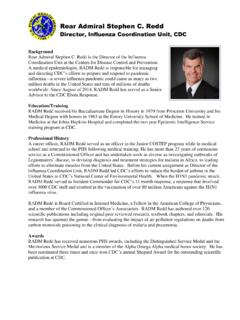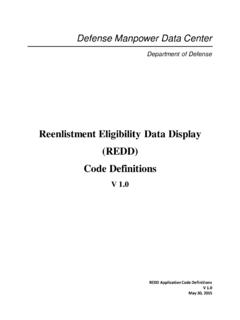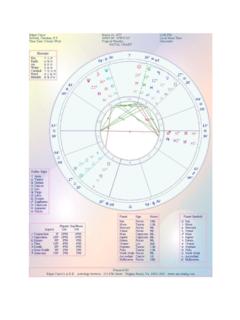Transcription of What is REDD?
1 Project Team: Heather Abbey Carolyn Ching Tyson Eckerle Scott Webb Emily Welborn Project Advisor: Christina Tague Client: Foundation for the Survival of the Cof n REDUCING EMISSIONS FROM DEFORESTATION AND DEGRADATION ( redd ) IN THE COF N BERMEJO RESERVE, ECUADOR on the web at: ~cofan March 2009 The Cof n Bermejo Reserve is a 55,451-hectare tract of primary Amazon rainforest located in northeastern Ecuador, bordering Colombia. Cof n Bermejo was established in 2002 by the Ministry of Environment of Ecuador as an ecological reserve under the condition that it would be sustainably managed and stewarded by the indigenous Cof n people. The Cof n have sustainably subsisted in the Amazonian rainforests of Ecuador and Colombia for centuries.
2 The establishment of the Cof n Bermejo Reserve marked the first instance in Ecuador in which an indigenous group was granted the rights to manage, administer, and control their ancestral territories. Despite the Cof n Bermejo status as an ecological reserve, the Cof n receive no funding from the Ecuadorian government for its protection. Throughout Ecuador, activities such as road construction, government infrastructure projects, oil, mining, mono-cultivation plantations, timber extraction, weak land tenure, and poverty have led to significant land use changes, and ultimately deforestation (Mena et al. 2006). Between 2000 and 2005, Ecuador lost percent of its forested area per year, constituting the highest deforestation rate within South America (Mena et al.)
3 2006, FAO 2005). Reserve status does not always protect areas from deforestation, as governments often grant concessions and illegal deforestation is widespread. The Sucumb os Province, where the Reserve is located, has a historic deforestation rate of approximately percent per year (Vi a et al. 2004). Similarly, the pressure of deforestation on the Cof n Bermejo Reserve is high and likely to increase in the future. What is redd ? Tropical rainforests provide one of the greatest vegetative carbon stores on the planet; consequently, deforestation results in a significant loss of carbon into Figure 1: Map of the Cof n Bermejo Reserve (circled) and Other Cof n Territories along the Ecuador and Colombia Border.
4 redd in the Cof n Bermejo Reserve, Ecuador April 2009 2 the atmosphere (FAO 2006). According to the Intergovernmental Panel on Climate Change (IPCC) (2007), land use change, including deforestation, accounts for 18 to 20 percent of global annual greenhouse gas emissions (Figure 2). In December 2007, the United Nations Framework Convention on Climate Change (UNFCCC) acknowledged the considerable contribution of emissions from deforestation and forest degradation activities to climate change. Subsequently, the UNFCCC has requested further research into developing a mechanism for reducing emissions from deforestation and forest degradation ( redd ) and using such a mechanism in an international carbon emissions trading scheme.
5 In the absence of an UNFCCC sanctioned redd trading mechanism, voluntary markets have emerged to allow for the trading of carbon emissions credits generated from redd projects. Figure 2: Greenhouse Gas Emissions by Sector. According to the IPCC and WRI Climate Analysis Indicator Tool (CAIT), land-use change and forestry, which includes deforestation and degradation, accounts for 18 to 20 percent of greenhouse gas emissions into the atmosphere. The Cof n are interested in creating a redd project for the Cof n Bermejo Reserve to generate a sustainable income for maintaining effective stewardship of their territories. Much of the funding generated by a redd project would be directed to the Cof n Park Guard Program.
6 Cof n park guards provide on-the-ground surveillance, biological research, and long-term monitoring of changes within the forest, and are the only source of forest protection. This program operates through inconsistent grant funding. In its current capacity, the Park Guard program lacks the resources to sufficiently protect the Reserve from deforestation. redd -based carbon market funding can provide the consistent funds necessary to improve the Park Guard Program in order to preserve both the Cof n Bermejo Reserve and the Cof n way-of-life. Research Question: Is it feasible and economically viable for the Cof n to develop a redd project for the Cof n Bermejo Reserve? Feasibility Analysis This project analyzes the feasibility of entering the Cof n Bermejo Reserve into a redd -based carbon market by considering criteria used in existing voluntary market standards.
7 Highlights from this analysis include: redd Standards - Currently, redd projects are not recognized by the UNFCCC. However, voluntary market standards can be used to develop certifiable, redd -based carbon emissions reduction credits. Should the UNFCCC adopt redd , these voluntary market standards will influence the shape of future regulations. Political Climate of Ecuador - Recently, Ecuador adopted a new Constitution, which provides additional rights to nature and indigenous groups, and developed Socio Bosque, a program that provides incentives for forest protection. These recent developments highlight Ecuador s recognition of the value of its ecological resources and interest in developing national-based programs that utilize market mechanisms to protect them.
8 A redd project in the Cof n Bermejo Reserve would likely gain government support, but uncertainty surrounds the distribution of benefits. Carbon Stock and the Potential for Loss Based on a literature review of comparative forests in South America and a limited field study, we estimate a potential deforestation rate of percent per year, leading to a loss of 200 to 300 metric tons of carbon per hectare (Houghton 1999; Defries et al. 2002; IPCC 2006; Butler 2007). A redd project would be designed to prevent the loss of this carbon stock. Additionality Most redd standards require that a project can demonstrate emission reduction benefits in addition to a business-as-usual scenario.
9 Reserves typically do not qualify because the forest and its carbon stocks are already protected. However, we argue that a case can be made for redd projects for reserves in developing nations, including the Cof n Bermejo Reserve. These reserves are often subject to forest loss through illegal deforestation and development within protected areas because of government concessions. Considering this potential for carbon loss, a redd redd in the Cof n Bermejo Reserve, Ecuador April 2009 3 project for the Reserve would reduce emissions beyond a business-as-usual scenario. Leakage The development of a redd project for the Reserve will only prohibit large-scale extractive activities of forest resources.
10 Currently, extractive forest activities within the Reserve are limited to subsistence use by the Cof n. Sustainable use of the forest will not be limited by the implementation of a redd project. Therefore, leakage, or the displacement of deforestation to other areas, is not expected to occur in the development of a redd project. Non-permanence Ideally, a redd project for the Reserve will enhance the Park Guard Program and thereby prevent anthropogenic deforestation. However, it is necessary to address the potential for unexpected carbon loss. Natural disturbances and infrastructure development within the Reserve present a low to medium risk of unexpected carbon loss. To address this risk of non-permanence, this redd project must set aside a defined amount of salable carbon emission credits based on the level of risk.



















